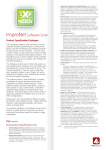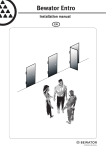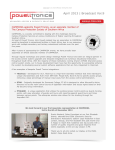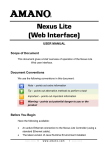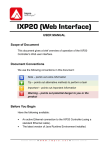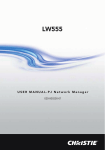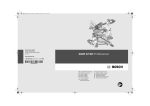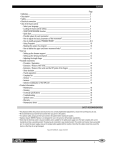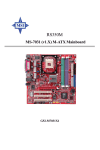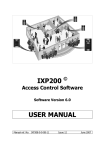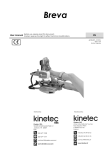Download PDF Formatted User Manual
Transcript
FCC VERSION IXP 100 SERIES SINGLE-DOOR ACCESS CONTROL SYSTEMS SYSTEM 101 - IXP901-1-0-GB-XX USER MANUAL Manual ref number: IXP300-0-0-GB-02 Issue 3 November 2001 IMPORTANT NOTICE Although all efforts have been made to make this manual as accurate as possible, Impro Technologies (Pty) Ltd does NOT accept any liability for errors or omissions. The data contained in this manual supersedes any other information published on the product. We further reserve the right to amend or improve the equipment and manual without notice. GUARANTEE / WARRANTY Impro Technologies (Pty) Ltd warrants that the Products furnished under this agreement will be free from material defects in material and workmanship for a period three years from the date of shipment. The Customer shall provide notice to Impro Technologies (Pty) Ltd of each such defect within one week after the Customer's discovery of such defect. The sole obligation and liability of Impro Technologies (Pty) Ltd under this warranty shall be to repair or replace at Impro's sole discretion, but without cost to the Customer, the product or part which is so defective and as to which such notice is given. Upon request by Impro Technologies (Pty) Ltd, the product or part claimed to be defective shall immediately be returned at the Customer's expense to Impro Technologies (Pty) Ltd. Replaced or repaired products or parts will be shipped to the Customer at the expense of Impro Technologies (Pty) Ltd. There shall be no warranty or liability for any products or parts which have been subject to misuse, accident, negligence, failure of electric power or modification by the Customer without Impro Technologies (Pty) Ltd written approval. Final determination of warranty eligibility shall be made by Impro Technologies (Pty) Ltd. If a warranty claim is considered invalid for any reason, the Customer will be charged for services performed and expenses incurred by Impro Technologies (Pty) Ltd in handling and shipping the returned item. As to replacement parts supplied or repairs made during the original warranty period, the warranty period of the replacement or repaired part shall terminate with the termination of the warranty period with respect to the original product or part. As Impro Technologies (Pty) Ltd has no control over where the product is used, or how it is installed, no liability for ANY consequential damages can be accepted, whether due to malfunction, design, deficiency, implementation or any cause whatsoever. Impro Technologies does not guarantee interfacing compatibility of any of its equipment with any third-party equipment, regardless of any standards which may be applicable. Connecting third-party equipment to any Impro equipment may compromise the functionality of the Impro equipment and render it inoperative. THE FOREGOING WARRANTY CONSTITUTES IMPRO TECHNOLOGIES (PTY) LTD SOLE LIABILITY AND THE CUSTOMERS SOLE REMEDY WITH RESPECT TO THE PRODUCTS AND IS IN LIEU OF ALL OTHER WARRANTIES, LIABILITIES AND REMEDIES EXCEPT AS THUS PROVIDED, IMPRO TECHNOLOGIES (PTY) LTD DISCLAIMS ALL WARRANTIES, EXPRESS OR IMPLIED, INCLUDING ANY WARRANTY OF MERCHANTABILITY OR FITNESS FOR A PARTICULAR PURPOSE. This product is designed and manufactured by: R 47 Gillitts Road Pinetown South Africa 3610 P O Box 15407 Westmead South Africa 3608 © November 2001 Impro Technologies Data subject to change without notice (031) 700-1087 (031) 700-1511 (e-mail) [email protected] Page 2 IXP 100 SERIES System 101 USER MANUAL CONTENTS IMPORTANT NOTICE..........................................................................................2 GUARANTEE / WARRANTY ..................................................................................2 INTRODUCTION ................................................................................................5 THE USE OF THIS MANUAL .................................................................................6 SPECIAL TERMS USED IN THIS MANUAL...............................................................6 GENERAL DESCRIPTION .....................................................................................7 SYSTEM DESCRIPTION.......................................................................................7 Overview ...................................................................................................7 Door Entry Unit...........................................................................................8 Door Control Unit........................................................................................8 Door Strike /Maglock ...................................................................................8 RTE Button ................................................................................................8 Alarm Panel/Siren .......................................................................................9 12V Lead Acid Battery and AC Transformer.....................................................9 SYSTEM DEFAULTS..............................................................................................9 MODES OF OPERATION ..................................................................................... 10 Hardware Modes....................................................................................... 10 Intrusion Mode ......................................................................................... 10 Alarm Mode ............................................................................................. 11 ALARM MODE OPERATION............................................................................... 11 SYSTEM MODES ....................................................................................... 11 Normal Mode............................................................................................ 12 Programming Mode................................................................................... 12 GENERAL OPERATION...................................................................................... 13 PIN Codes, Reason Codes & Access Levels.................................................... 13 PIN Modes ............................................................................................... 14 USE OF FLOW DIAGRAMS TO DESCRIBE OPERATIONS ......................................... 14 Alarm Disarming PIN Code/Supervisor Unlock ............................................... 15 Arming the Alarm/Supervisor Lock............................................................... 15 Use of Reason Codes................................................................................. 16 Tag Presented – Arming / Disarming............................................................ 16 Tag Presented – Access ............................................................................. 17 Incorrect PIN Code Entry ........................................................................... 17 Door Forced/Door Open/Door Not Opened.................................................... 17 Special Function Mode (Long Duration Keypress)........................................... 18 Alarm Arming/Supervisor Lock .................................................................... 18 Relaxed/Enforced PIN codes....................................................................... 19 Status LED Quieting .................................................................................. 19 Tag Suspension ........................................................................................ 19 Door Lock/Unlock...................................................................................... 20 Changing PIN Codes.................................................................................. 20 AC Power Failure ...................................................................................... 20 Entering Programming Mode....................................................................... 21 PROGRAMMING MODE ..................................................................................... 21 General Editing Functions ................................................................................ 21 © November 2001 Impro Technologies Data subject to change without notice Page 3 Adding Tagholders – Command Code 01............................................................ 22 Editing Tagholders - Command Code 02 ............................................................ 23 Replacing Tags - Command Code 03 ................................................................. 23 Deleting Tagholders (Known Location) - Command Code 04 ................................. 24 Deleting Tagholders (Unknown Location) – Command Code 05 ............................. 24 Time Patterns - Command Code 06................................................................... 24 Changing Alarm Modes – Command Code 07...................................................... 25 Replacing Tags (Old Tag Available) – Command Code 08 ..................................... 25 Deleting the Transaction Table - Command Code 10............................................ 25 Changing the Relay #1 (Latch) Drive Time - Command Code 11............................ 26 Changing the Relay #2 (Alarm) Drive Mode & Time - Command Code 12 ............... 26 Configuring the Real Time Clock - Command Code 13.......................................... 27 Changing the Black-listed Tag Timeout Period - Command Code 14 ....................... 27 Changing the Present Tag Timeout Period - Command Code 15 ............................ 27 Changing the Key Entry Timeout Period - Command Code 16................................ 28 Changing the Alarm Ready Input Sensing - Command Code 17 ............................. 28 Changing the Buzzer Volume - Command Code 18 .............................................. 29 Changing the Reason Code Length - Command Code 19 ...................................... 29 Changing the Door Left Open Period - Command Code 20.................................... 29 Changing the Door Not Opened Period - Command Code 21................................. 30 Changing the AC Power Fail Alarm Period - Command Code 22 ............................. 30 Changing the Reason Codes Required - Command Code 23 .................................. 30 Changing the Special Function Keypress Time - Command Code 24 ....................... 31 Changing the No Keypress Timeout – Command Code 25..................................... 31 Changing the Request to Exit Input Sense – Command Code 26............................ 31 Quick Tag Entry - Command Code 27................................................................ 32 Set PIN Mode – Command Code 28................................................................... 32 Set PIN-only Code - Command Code 29............................................................. 32 TRANSACTION TYPES ........................................................................................... 32 INSTALLER TECHNICAL FUNCTIONS ....................................................................... 33 Deleting the Database..................................................................................... 33 Replacing the DEU.......................................................................................... 34 Restore Factory Defaults.................................................................................. 34 Firmware Upgrade of the DCU.......................................................................... 34 PC Software Configuration ............................................................................... 34 TAGHOLDER RECORD ........................................................................................... 34 DIAGRAMS Figure 1 : System block diagram ...............................................................................9 TABLES Table 1 : DEU/PC Functions......................................................................................6 Table 2 : System Default Settings............................................................................ 10 Table 3 : Intrusion Mode of Operation ..................................................................... 11 Table 4 : Alarm Mode Operation ............................................................................. 11 Table 5 : LED/Buzzer Indications in Normal Mode...................................................... 12 Table 6 : Special Function Keys............................................................................... 18 Table 7 : Transaction Types ................................................................................... 33 Table 8 : User Tag Record Table............................................................................. 35 © November 2001 Impro Technologies Data subject to change without notice Page 4 INTRODUCTION The IXP 100 Series is a high-security access control system, intended to control the access of up to 500 users through a single door. Instead of a normal mechanical key, the door can only be opened from the outside when a valid Tag is presented to the unit. Advanced security features prevent the door latch being operated from the outside even if the wiring is tampered with, and even if the outside unit is substituted with another unit. The advantage of using a Tag is that if a Tag is lost, details of the Tag can be removed from the system, and there is no need to change door locks. For added security, the system can be programmed so that, in addition to presenting a Tag, a 4-digit personal identification number [PIN] is also required to be entered via the keypad before access is allowed. Three Tagholder levels are provided for: LEVEL LIMITATIONS User May enter during specified time periods only. Supervisor May enter at all times. Administrator As for Supervisor but is also able to programme the system. The system comprises three major components: • Door Entry Unit (DEU). • Door Control Unit (DCU). • PC Software. To provide a variety of features while keeping the system easy to use, certain advanced functions and facilities are not selectable using the keypad unit. These functions are only selectable by means of the PC software program. For typical installations where these more advanced facilities are not required, the use of a PC is not necessary, and the basic set-up can be performed using the Keypad DEU if the default settings need to be changed. The system is programmed at the factory to provide certain default functions. Table 1 shows the different functions which can be performed using the PC or the Keypad DEU on its own. © November 2001 Impro Technologies Data subject to change without notice Page 5 FUNCTION DEU PC Add/Edit/Delete Tags. Yes Yes Set basic system parameters (e.g. Buzzer volume). Yes Yes Keep short term records of events (Last 500 events). Yes Yes Keep long term records of events. No Yes Set advanced system parameters (e.g. Transaction Types). No Yes Table 1 : DEU/PC functions THE USE OF THIS MANUAL This manual will help you to make any changes necessary to the system settings for the IXP 100 Access Control System. The changes are all made by pressing keys on the Keypad Door Entry Unit (DEU) which is mounted on the outside of the door in your building. The response of the system to changes which you make is indicated visually (via the light (LED) in the DEU) and audibly (via the buzzer in the DEU). If you have a PC, then these changes can be made using the IXP 100 Series Software which must be installed on the PC. You will find that using the PC for this will be easier than using the keypad. The use of the PC software is described in the IXP 100 Series Software Manual. SPECIAL TERMS USED IN THIS MANUAL Some special terms are used in this manual. In order to operate your IXP 100 Series System you will need to be familiar with these terms. There is no need to learn these definitions; you can simply refer to the explanations given when necessary. The terms are explained below. TERM DESCRIPTION Administrator : As per Supervisor, but is also able to program the system. Alarm Panel : A separate alarm system connected to the IXP 100 system. Arming : Setting the alarm system into its operational state. Client's staff : Persons employed by the owner of the system. Configurable : Can be changed by the client. Default : The factory setting for an operation, which can be modified by the client. Disarming : Setting the alarm system into its non-operational state. Flag : The word “flag” indicates that a condition is enabled, permitting a related operation to be performed. Function : An operation which the system can perform. © November 2001 Impro Technologies Data subject to change without notice Page 6 TERM DESCRIPTION Intrusion : Unauthorized entry. Parameter : A quantity (for example a Mode or Time period) which may be set to different values. Present a Tag : Pass or hold a tag close to the DEU front panel. Reason Code : A code which indicates the reason for access. Supervisor : A tagholder authorized to enter at all times. Time Pattern : Entry control periods. Transaction : Presentation of a tag and the system response to this. Transaction Buffer : Storage of transaction information. Transaction Data : Transaction information. Transaction Event : Detection of a transaction. User : Person issued with a tag for access purposes only. Valid Tag : A tag which has previously been entered into the system database and is not black-listed. IMPORTANT NOTE UNTIL YOU BECOME FAMILIAR WITH THE IXP 100 SYSTEM, YOU MAY ENCOUNTER PROBLEMS IN SETTING UP THE SYSTEM OR IN MAKING CHANGES TO THE SETTINGS. IF SO, PLEASE CONTACT YOUR LOCAL IMPRO DISTRIBUTOR. YOUR DISTRIBUTOR’S DETAILS CAN BE OBTAINED FROM THE DEALER FROM WHOM YOUR SYSTEM WAS PURCHASED. GENERAL DESCRIPTION SYSTEM DESCRIPTION You will need an understanding of the parts which make up the system, and the way in which the system operates to : • make sure that the system does what your company requires when it is first installed. • be able to alter tag information. • make any later changes to the system settings that you require. (in other words to administer or supervise the IXP 100 System). This section provides this description. Overview A block diagram (a diagram which shows how the parts of the system are connected together) is given in Figure 1. © November 2001 Impro Technologies Data subject to change without notice Page 7 Door Entry Unit (Item A in Figure 1) Three types of Door Entry Unit (DEU) are available, but this manual applies only to the IXP 100 System 101, which uses the Keypad Door Entry Unit. The Keypad DEU has the following operating features : • It is able to detect tags. • The keypad is used to make changes to the system programming. • The keypad can be used to enter Personal Identification Numbers (PIN numbers). • The keypad can also be used to enter Reason Codes. • A buzzer to provide information to the user by means of different combinations of beeps. • A light (an LED) to provide information to the user by means of different length flashes of different colors. The DEU and the Door Control Unit (DCU) communicate with each other. For example, when a tag is presented to the DEU, the tag ID is sent to the DCU, which searches its memory to decide whether that tag is allowed access at the time. This information is then sent to the DEU, which then causes the DEU buzzer to sound and the DEU LED to be lit to tell the tagholder, for example, that the system will allow/disallow him entry. The Door Control Unit (Item E in Figure 1) This unit is the intelligent part of the system. It contains the program that governs the way the system functions. This program is loaded into the unit at the factory with a default program that provides functions suitable for most typical installations. The default functions can be altered using the keypad in the DEU (as described in this manual) or by using the IXP Software loaded onto a PC (item G in Figure 1) as described in the IXP 100 System Software User Manual. The DCU provides the following functions: • It accepts data from the DEU, and controls the operation of the buzzer and LED in the DEU. • It controls the operation of the Door Strike/Maglock (item B in Figure 1), which is the door locking mechanism on the door controlled by the system. • When the “Request to Exit” pushbutton (item C in Figure 1) is pressed, the DCU responds by causing the Door Strike/Maglock to open. • The system can be connected so that a Door Open Sensor indicates to the DCU that the door is open, or so that an alarm indication from an Alarm Panel is fed to the DCU (item D in Figure 1). Information about how your system is connected should be available at your site. • The system is normally powered from an AC transformer (item I in Figure 1). Door Strike/Maglock (Item B in Figure 1) This the special door lock which is controlled by the IXP 100 system. RTE Button (Item C in Figure 1) This the “Request to Exit” pushbutton which is normally located at a point close to the door, and allows manual opening of the door from the secure side. © November 2001 Impro Technologies Data subject to change without notice Page 8 Alarm Panel / Siren (Item H in Figure 1) Your system will include either an alarm panel, or a siren. The siren is installed where a simple intrusion alarm is required. 12V Lead Acid Battery and AC Transformer (Items F and I in Figure 1) These items provide power to the system. The battery is used to power the system when the AC supply fails. Door Entry Unit (DEU) A Door Strike/ Maglock Communications between the DCU and PC. Communications between the DCU and DEU. Relay # 1 B Relay # 2 Door Control Unit (DCU) E RTE Button D Alarm Panel/ Siren H 13.8 V Charge Input #2 C Door Open Sensor/Alarm Panel PC with IXP 100 Software G 14 V - 18 V AC 2A 12 V Lead Acid Battery Input #1 MAINS POWER AC Transformer F I IXP 100 System Overview.wmf NOTE : Shaded boxes are Impro-supplied Figure 1 : System block diagram SYSTEM DEFAULTS The system is shipped from the factory with default settings for those parameters which can be modified by the user's staff. SYSTEM DEFAULT SETTINGS FACTORY DEFAULT PARAMETER AC Power Fail Alarm Period 5 min. Alarm Disarming Administrator and Supervisor tagholders. Blacklisted Time-out Period 0030 (0 hours 30 minutes). Buzzer Volume Level 3. Time Pattern Allows access 24 hours per day, 7 days per week. Door Left Open Period 0 s / not active. © November 2001 Impro Technologies Data subject to change without notice Page 9 SYSTEM DEFAULT SETTINGS FACTORY DEFAULT PARAMETER Door Not Open Period 0 s / not active. Key Entry Time 60 seconds. No Key Entry Timeout Period 120 seconds (requires tag presentation to reactivate). Mode of Operation Intrusion Mode. Present Tag Timeout Period 10 seconds. Reason Code Entry Disabled. Reason Code Length 2 digits. Relay#1 (Latch) Drive Time 30 (3 seconds). Relay#2 (Alarm Drive Time) 300 (30 seconds). Tagholder Level 0 (User). Time and Date 01 January 2000. Time Patterns Start Time = 00H00, Duration = 24H00 for every day of the week. Table 2 : System default settings MODES OF OPERATION Four Modes of operation are provided in the system. Of these, two are DCU Hardware Modes (see "Hardware Modes") and two are System Modes (see "System Modes"). Hardware Modes The DCU operates in one of two hardware modes : • Intrusion Mode. • Alarm Mode. The changing of hardware modes can only be performed by the Administrator tagholder (refer to the paragraph "Programming Mode"). Intrusion Mode The Intrusion Mode can be used where there is no installed alarm panel and a simple intrusion alarm is required. In this mode the Relay #2 is used to activate a siren when the Door Open Sensor is triggered and the unit has been Armed. Arming will only be permitted in normal operation if the Door Open Sensor is in the correct state. Additional contact sensors can be connected in series or parallel to Input #1 to extend this function beyond the access door alone to other doors. The normally open or normally closed state can be set by the Administrator (refer to the installer for further information). The siren activation period which applies when the alarm has been triggered can also be set by the Administrator. © November 2001 Impro Technologies Data subject to change without notice Page 10 Intrusion Mode – No Installed Alarm Panel Relay #1 (LATCH) Operates the Door Strike Relay #2 (ALARM) Operates the Siren Input #1 (SEN) From the Door Open Sensor Input #2 (RTE) From the Request to Exit Pushbutton Table 3 : Intrusion Mode of Operation Alarm Mode The Alarm Mode is used where there is an installed alarm panel. Alarm Mode – Use in conjunction with installed Alarm Panel Relay #1 (LATCH) Operates the Door Strike Relay #2 (ALARM) Connected to Alarm Panel for Arm / Disarm Input #1 (RDY) From the Alarm Panel “Ready” Status Input Input #2 (RTE) From the Request to Exit Pushbutton Table 4 : Alarm Mode Operation ALARM MODE OPERATION Operation in the Alarm Mode is only possible if an Alarm Panel has been installed in your system. In this case, Arming / disarming can be controlled by relay#2 in the DCU. Input #1 is used to sense the “Ready” state of the Alarm Panel as the alarm cannot normally be Armed unless it is “Ready”. This “Ready” state is represented by the LED mode of the DEU and will prevent Arming if not “Ready”. SYSTEM MODES The system operates in one of two modes, namely Normal Mode and Programming Mode : [a] The Normal Mode of operation is the default mode in which the DEU allows access and Reason Codes to be entered together with the presentation of a tag. Audio and visual indications for the various conditions which can occur in the Normal Mode are described in Table 1. [b] The Programming Mode is entered under control of the Administrator tagholder and allows for the management of tag tables, settings, and operational parameters. The Programming Mode requires the use of the DEU, so that access control is not possible while in this mode. © November 2001 Impro Technologies Data subject to change without notice Page 11 Normal Mode The table below shows the LED and buzzer states which can occur when a tag is presented or a key is pressed for a long time (a long duration keypress) (1-3 seconds): CONDITION INDICATION AT DEU LED STATUS Present Tag Valid Tag Presented Invalid Tag Presented Awaiting PIN Code Valid PIN Entered Invalid PIN Entered Awaiting Reason Code Keypress Alarm Triggered Fault Programming Mode WHAT THIS MEANS BUZZER Steady Red + Blink Off Off Steady Green Beep Intermittent. On for 1s Slow Red Blink On for 2s Alternate Red / Green Blink Steady Green Off Normal Mode – Alarm Disarmed not Ready. Normal Mode – Alarm Armed. Normal Mode – Alarm Disarmed and Ready. Normal Mode as above but with AC Power Failure. LED Green whilst Relay#1 being driven. Tag ID not recognised OR access denied. Waiting for PIN. Steady Red Steady Red + Green Blink Orange instead of Red Off Off On for 1s Valid PIN Received. Fast Orange Blink On for 2s An invalid PIN received. Slow Orange Blink On for 0.2s Waiting for Reason Code. Red Flash Continuous On for 0.1s Off Keypress acknowledge tone. Flash to indicate alarm triggered. Fast Red/Green Blink Fast Red Flash Off Off Fault condition detected. Waiting for commands. Table 5 : LED/Buzzer indications in Normal Mode Programming Mode In the Programming Mode, the facilities described in the following paragraphs can be programmed into the system from the keypad . (a) There are 500 user memory locations in which Tags can be entered, deleted or replaced. (b) These operations must be managed carefully so that the correct location is used when entering, deleting or replacing Tags. (c) A good practice is to assign a location to the person to whom the Tag was given. Table 9 at the end of this manual will assist you with this. © November 2001 Impro Technologies Data subject to change without notice Page 12 IMPORTANT NOTE At least one tag must be given Administrator level in order to restrict access to the Programming Mode. If no tag is given this level, any tag will allow access to the Programming Mode. This would allow any user to program the system, with possible disastrous consequences. The Programming Mode can be used only if the DCU has been disconnected from the PC. GENERAL OPERATION • The system will not allow access through the controlled door unless a valid tag (that is, one that has been entered into the system) has been presented to the DEU. • • If the system has been configured so that a PIN is required for the tag, this must be entered within the Key Entry Time (this can be changed; the default is 60s) after the tag is presented. If not, the system will deny access. During the Armed status, automatic disarming occurs when an Administrator or Supervisor tag is presented followed by a valid PIN Code. In Normal Mode, the DCU waits either for a tag to be presented, or for a long duration keypress to be detected : • • • Presenting a tag first indicates a request for access through the door, and the possible entry of a Reason Code or PIN Code. A long duration keypress, followed by a presented tag, followed by a PIN Code, a special function such as entering Programming Mode (an Administrator level tag is required for this). The keypad becomes inactive after No Key Timeout (this is configurable by the Administrator – the default is 120 s), and requires a tag to be presented to reactivate it. PIN Codes, Reason Codes & Access Levels • A PIN Code must be setup for the Administrator and Supervisor level tagholders who have the responsibility of alarm disarming. • • The allocation of a PIN Code for User level tagholders is optional. This is done on a per-tagholder basis for access control. Only a single PIN Code can be assigned to a tagholder at any tag level. • The tagholder-selected PIN is used for normal door access (if required) and also for the special function key operations (refer to “Special Function Key Operations”). • Any tag assigned a non-zero PIN Code when adding tags using the keypad, will be required to use it for access whenever PIN codes are enforced (refer to “Special Function Keys 2 and 3 ”). If a PIN Code has been assigned to a tag for special function purposes and PIN Codes are enforced but not required by that particular tag for normal access, then the PIN Code requirement can only be relaxed for that tag using the PC Software (refer to the IXP 100 Series Software Manual for details). • © November 2001 Impro Technologies Data subject to change without notice Page 13 • Users can change but cannot delete their own PINs; they can only be deleted by an Administrator. PIN Modes The IXP100 System offers the option of three PIN Modes. These PIN Modes operate in conjunction with the Time Pattern Settings. The conditions for each PIN Mode are described in the table below. NOTE : “Open” time periods are those periods when access is allowed for user tagholders; “Restricted” time periods are those periods when access is only allowed to Administrator and Supervisor tag levels. Time Pattern PIN Mode Open Restricted All tags allowed. Mode 1 Configurable PIN Only Administrator/ Supervisor tags allowed. PIN must be entered on presentation of a tag if a PIN has been set for that tag, and if the PIN Enforced condition is set as part of the current Time Pattern. All tags allowed. PIN not required. Mode 2 – Restricted PIN Only Administrator/ Supervisor tags allowed access. PIN required if set for that tag. The PIN Enforced/Relaxed Time Pattern setting is ignored in this Mode. Mode 3 - PIN-only All tags allowed. Global PIN allows access even without presentation of a tag. Only Administrator/ Supervisor tags allowed access. PIN required if set for that tag. The PIN Enforced/Relaxed Time Pattern setting is ignored in this Mode. USE OF FLOW DIAGRAMS TO DESCRIBE OPERATIONS In the following text, use has been made of flow diagrams to show the sequence of actions which have to be taken to complete various operations. For people not familiar with flow diagrams, here is an explanation of how to use them. Real examples have been used. Example 1 Arming the Alarm / Supervisor Lock This sequence arms the alarm in Alarm mode, or permits the Supervisor to lock the door in Intrusion Mode. For 4 sec. 0 Present a valid Tag This means that, in order to complete the operation of Arming the Alarm (for example), the tagholder must : © November 2001 Impro Technologies Data subject to change without notice Page 14 [1] Press the “0” key for 4 seconds. [2] Present a valid tag. Example 2 Deleting Tagholders (Known Location) – Command Code 04 Enter a table entry number for the tag you want to delete For 4 sec. # Present the Admin. Tag Confirm Enter valid PIN Code X X # 1 # Cancel 0 4 # Deleting a tag 0 To perform this function, the Administrator must : [1] Press the “#” key for 4 seconds. [2] Present the Administrator tag. [3] Enter a valid PIN code, followed by the code 04#. [4] Enter the table entry number relating to the tag to be deleted. [5] Press the “#” key. [6] The Administrator can then either : (a) Press “1” to confirm the deletion, or (b) Press “0” to cancel the deletion. [7] After step 6(a) or 6(b), press “#” to cause the system to complete the required action. These principles apply to all the flow diagrams in this manual. NOTE : The brochure “ A Quick Guide to Common IXP 100 Operations”, which uses these diagrams is packed with your system for easy reference when you are performing the more common operations. Alarm Disarming PIN Code / Supervisor Unlock The PIN Code for disarming the alarm (at Administrator and Supervisor level only) is the normal access PIN Code which is allocated to their tags. The DCU memorises the Armed / Disarmed state and therefore does not require a different PIN Code for disarming – this function is performed automatically by the DCU. Arming the Alarm / Supervisor Lock This sequence arms the alarm in Alarm mode, or permits the Supervisor to lock the door in Intrusion Mode. © November 2001 Impro Technologies Data subject to change without notice Page 15 The Arming of the alarm is performed by the “Special Function Keypress” where the tagholder : For 4 sec. 0 Present a valid Tag It is therefore necessary for all User level tagholders who are authorised to Arm the Alarm Panel to be assigned a PIN Code. Use of Reason Codes In certain applications it may be necessary for Reason Codes to be entered by a tagholder as part of the access process. A Reason Code is a two digit (default length) code that is entered after a tag has been presented and the PIN Code (which is optional and can be required or not required by the system setup) has been keyed in. The Reason Code allocation is configured on a per tagholder basis (as per PIN Codes) and forms part of the programming process when adding or editing a tag (this is an Administrator level function). If a Reason Code is required by the system, the DEU will prompt for entry of this code by means of the LED and/or buzzer (see Table 2 for details) and the tagholder will be required to enter the Reason Code within the Key Entry Time period (configurable parameter – the default is 60s). Door access will only be granted once the Reason Code has been entered. Tag Presented – Arming / Disarming Only authorised tagholders (Administrator & Supervisor) are able to Arm and Disarm the alarm by means of their tag and PIN. Alarm Arming for User tags can enabled / disabled on a per-tagholder basis when adding / editing tags. Tagholders who are not authorised for disarming are prevented from entering the premises once the alarm has been set (armed). Indications given by the buzzer and LED indicate whether the alarm is Ready / Armed / disarmed or triggered (refer to Table 2 for details). If the system is in the Armed state, only the Administrator or Supervisor tag will be accepted and the DEU will prompt for the PIN entry, followed by the entry of a Reason Code (if required in your system). Once the correct PIN has been entered, along with the Reason Code (if required), the DCU will activate Relay#2 (according to its defined mode). If the hardware configuration mode is the Alarm Mode, this will instruct the alarm panel to Disarm. The DCU will then activate Relay#1 for the door strike according to the pre-configured parameters. © November 2001 Impro Technologies Data subject to change without notice Page 16 In order to Arm the alarm (if the current alarm status is Disarmed), a Special Function Keypress is used. A Special Function Keypress is the continuous pressing of a key for a period of 4 seconds. Tag Presented – Access The system first establishes whether the alarm is Armed or Disarmed according to the internal state of the DCU. If the internal alarm status is Disarmed when a tag is presented, the Relay#1 will be activated as above for both Administrator and Supervisor level tags with the exception that the PIN Code is not mandatory. If a User tag is presented, the DCU will first check for a valid Time Pattern. The Time Patterns provide for a single access period on a per-day basis whereby access will be granted to User level tagholders after tag presentation and a valid PIN Code (if required in your system). The Time Pattern requires the entry of a start time and a duration, which can be different for each day of the week. Time Patterns can be entered / edited by the Administrator level tagholder only. The default Time Pattern will allow access 24 hours per day, 7 days per week. Incorrect PIN Code Entry If a PIN Code is entered incorrectly three times in succession for a given tag, the tag will be rejected for the pre-configured Blacklisted Tag Timeout Period (see “Blacklisted Tag Timeout”). The DCU maintains a table of up to 10 tags recording those with incorrect PIN Codes having been entered. This table operates on a FIFO (first in, first out) basis. The blacklisting status of a Tag is cleared by an Administrator editing the Tag data. Door Forced / Door Left Open / Door Not Opened The system can sense whether the door was not closed after a normal access, whether the door was not opened after a normal access, or whether the door was forced without a normal access. (This applies to Intrusion Mode only where the door sensor is connected directly to the DCU – check whether this is the case for your system). A Door Not Closed Event will be indicated after the Door Not Closed period (this is a configurable parameter, with a default of 0s / not active) has expired and the door sensor continues to indicate an open status. This event will result in an appropriate transaction and will be indicated by the buzzer sounding rapidly for 10 s or until the door is closed. A Door Not Opened Event will be indicated if the door has not been opened before the Door Not Opened period (configurable parameter – default 0 s / not active) has expired. This event will result in an appropriate transaction only. A Door Forced Event will be automatically indicated as a transaction when the door open sensor activates without a valid preceding transaction. If the alarm is Armed, this will © November 2001 Impro Technologies Data subject to change without notice Page 17 automatically trigger the alarm. If the alarm is not Armed, this event will be indicated by the buzzer sounding rapidly for 10 s or until the door is closed. Special Function Mode (Long Duration Keypress) The continuous pressing of a key for a period of 4 seconds (configurable parameter) will cause the DCU to enter a Special Function Mode after a valid tag has been presented followed by a valid PIN Code (Reason Codes are not applicable here). The presentation of a valid tag must be made within 10 seconds (configurable parameter) of pressing the key, and the PIN Code must be entered within Key Entry Time of presenting the tag. The system must be in the Disarmed state. Table 6 below identifies the special functions available : Key Description 0 Arm normally using any authorised tag and PIN. 1 Arm with bypass using Administrator or Supervisor tag and PIN. 2 Relax PIN Code on all tags – Administrator / Supervisor only. 3 Enforce PIN Code on all tags where configured – Administrator / Supervisor only. 4 Toggle LED on/off at DEU during standby – Administrator / Supervisor only. 5 Suspend all Normal tags – Administrator / Supervisor only. 6 Resume all Normal tags – Administrator / Supervisor only. 7 Suspend all Supervisor tags – Administrator only. 8 Resume all Supervisor tags – Administrator only. 9 Toggle Door Locked / Unlocked – Administrator / Supervisor only. * Change tagholder PIN Code using valid tag and existing PIN. # I Administrator tag + valid PIN. Table 6 : Special Function Keys Alarm Arming / Supervisor Lock Normal Arming of the alarm requires that the alarm is “Ready”. The status of Input #1 will determine whether the alarm is Ready. For 4 sec. 0 Present a valid Tag In this case a valid tag is any tagholder level with the appropriate Arm Authority flag set – Administrator and Supervisor level tagholders have this flag set at all times and are thus automatically authorised for Arming. © November 2001 Impro Technologies Data subject to change without notice Page 18 Under certain circumstances it may be necessary to Arm the alarm with Bypass when it is not Ready – it may be that the alarm panel has one zone with a known fault but Arming is nevertheless required as the remaining zones are functional. For 4 sec. 1 This function is restricted to Adminiatrator and Supervisor level tagholder only. Present a valid Tag On Arming, the keypad is disabled and the latch relay is deactivated if it is currently active. Relaxed / Enforced PIN Codes This function relaxes the PIN Code entry requirement for normal access and is convenient when a door is in frequent use and presentation of a tag is sufficient. Relaxation of PIN Code entry on all tags: For 4 sec. 2 This function can only be selected by Administrator and Supervisor level tagholders. Present a valid Tag Enter a valid PIN Code Normal operation of the PIN Codes: For 4 sec. 3 This function can only be selected by Administrator and Supervisor level tagholders. Present a valid Tag Enter a valid PIN Code Status LED Quieting In order to prevent the DEU from drawing attention to itself by means of the LED activity, it is possible to set the status LED into a Quiet mode. The Quiet mode causes the status LED to be in an off state whilst waiting for a tag to be presented or for a long duration keypress. For 4 sec. 4 The Quiet mode can only be toggeld by Administrator and Supervisor level tagholders. Present a valid Tag Enter a valid PIN Code In the event that the alarm has been triggered whilst in Intrusion Mode, the status LED will override the Quiet mode and indicate the event in the usual manner. Tag Suspension Under certain circumstances it may be necessary to temporarily suspend all User level tagholders. © November 2001 Impro Technologies Data subject to change without notice Page 19 For 4 sec. 5 This function can only be access by Administrator and Supervisor level tagholders. Present a valid Tag Enter a valid PIN Code Cancel the suspension of the User level tagholders: For 4 sec. 6 This function can only be access by Administrator and Supervisor level tagholders. Present a valid Tag Enter a valid PIN Code A similar suspension can be performed for all Supervisor level tagholders: For 4 sec. 7 This function can only be access by Administrator level tagholders. Present a valid Tag Enter a valid PIN Code Cancel the suspension of the Supervisor level tagholders: For 4 sec. 8 Present a valid Tag Enter a valid PIN Code This function can only be access by Administrator level tagholders. Suspending Supervisor level tagholders does not automatically suspend User level tagholders. Door Lock / Unlock Under certain circumstances it may be necessary to keep the door in an unlocked state. This function can be accessed only when in the Disarmed state and resets back to the Door Locked state when the alarm is Armed. For 4 sec. 9 This function can only be access by Administrator and Supervisor level tagholders. Present a valid Tag Enter a valid PIN Code Changing PIN Codes All tagholders can alter their PIN Code themselves without assistance from Administrator or Supervisor level tagholders. This function is only accessible whilst the alarm is in a Disarmed state; also, the tagholder must already have a PIN Code assigned. The tagholder can configure a new PIN Code by following this sequence : For 4 sec. # Present the Admin. Tag Enter a valid existing PIN Code # Enter a new PIN Code Enter the new # PIN Code again # The new PIN Code will only be accepted and stored if both entries have been made without error. AC Power Failure The DCU detects failure of the AC power and generates an audio / visual response at the DEU after a disconnect period greater than 5 minutes (configurable parameter). The © November 2001 Impro Technologies Data subject to change without notice Page 20 Green LED on the DCU flashes and the LED on the DEU changes from Red to Orange immediately after a power failure. The buzzer will sound intermittently after 5 minutes. The condition will clear automatically once the AC power has been restored. A transaction will be logged for each AC power fail and restore. Entering Programming Mode In order to access the Programming Mode, the Administrator level tagholder must : For 4 sec. # Present a valid Tag Enter a valid PIN Code The Programming Mode functions are described under “PROGRAMMING MODE”. The Programming Mode is automatically exited if no key is pressed for a period of 60 seconds (this can be changed – see “Key Entry Time”). PROGRAMMING MODE All Programming Mode operations must be performed by an Administrator level tagholder. General Editing Functions When in Programming Mode, the following key sequences will be applicable throughout: • Pressing the * key once will clear the current programming function Ready for reentry of a parameter. • Pressing the * key twice in succession will exit out of the current programming function and return to Programming Mode. • • Pressing the * key three times in succession will exit out of programming mode completely. Pressing the # key will accept the current entry and proceed to the next step if the entry is valid, indicated by a Green LED. The # will also accept the default value automatically if a specific selection is not made. • Waiting for key entry indicated by fast flashing Red. See next page © November 2001 Impro Technologies Data subject to change without notice Page 21 Adding Tagholders – Command Code 01 A tag can only be entered into the system once, and any attempt to re-enter an existing tag will result in an error response. Each tag occupies a single fixed entry in a tags table and this entry point must be recorded manually by the Administrator. Entering Programming Mode For 4 sec. yes Keypad active no # Present any Tag Present Administrator Tag 1) PIN Code 0 1 # 1) When using a system the first time and having no tags entered, any Tag will do Table entry number Pressing the * key once will clear the digits entered and allow for the full table entry number to be re-entered. new Table entry number X X Present new Tag # Tagholder level User 0 Supervisor 1 Administrator 2 Level # An incorrect entry will result in an error signal and the Administrator will be required to reenter the tagholder level again. Pressing # without entering a tagholder level will accept the default level of 0. Arm/Disarm arm to allow Tag to 1 no arming Pressing # without entering a value will cause the system to accept the default settings. # # Reason Code yes Pressing # without entering a value will accept the default setting. Once the above flags have been entered, the system expects the Enable Reason Codes flag (all expected key entries are indicated by a fast-flashing Red LED) 1 # Reason Code no # PIN Code yes X X X X # PIN Code Editing a tag no PIN Code (4 Digits, Essential for Administrator + Supervisor) # © November 2001 Impro Technologies Data subject to change without notice Page 22 Editing Tagholders – Command Code 02 Enter a table entry number for the tag you want to edit For 4 sec. # Present the Admin. Tag Enter valid PIN Code 0 2 # # X X Tagholder level User 0 Supervisor 1 Administrator 2 Level An incorrect entry will result in an error signal and the Administrator will be required to reenter the tagholder level again. Pressing # without entering a tagholder level will leave the existing tagholder level unchanged. # Arm/Disarm arm 1 to allow Tag to Pressing # without entering a value will leave the existing value unchanged. # no arming # Reason Code yes Pressing # without entering a value will leave the existing value unchanged. 1 # Reason Code no # PIN Code yes PIN Code (4 Digits, Essential for Administrator + Supervisor) Pressing #without entering a PIN will leave the existing PIN Code unchanged. X X X X # PIN Code Editing a tag # no Replacing Tags – Command Code 03 Enter a table entry number for the tag you want to replace For 4 sec. # Present the Admin. Tag Enter valid PIN Code new PIN Code Present the new Tag 0 3 # X X X X existing PIN Code # PIN Code is no longer required © November 2001 Impro Technologies # X X Replacing a tag * Data subject to change without notice Page 23 Deleting Tagholders (Known Location) – Command Code 04 Enter a table entry number for the tag you want to delete For 4 sec. # Present the Admin. Tag Confirm Enter valid PIN Code X X # 1 # Cancel 0 4 # Deleting a tag 0 Deleting Tagholders (Unknown Location) – Command Code 05 For 4 sec. # Present the Admin. Tag Confirm Enter valid PIN Code Present the tag to be deleted 1 # Cancel 0 5 # Deleting a tag 0 Time Patterns – Command Code 06 For 4 sec. # Present the Admin. Tag Enter valid PIN Code 0 6 # D Day of the week D # Enter the Start Time 1) H H M M # 1) Enter the required Duration H H M M # 1) 24 hour clock format ... Day of the week 1 = Sunday to 7 = Saturday H ... Hour M ... Minute NOTES: 1. Pressing * at any time before # will clear the previous keystrokes (if any) to allow for re-entry. 2. The Start Time and Duration will be automatically checked for validity and will result in an error response (a slow Red LED blink and activation of the buzzer for 2 seconds) if incorrect. © November 2001 Impro Technologies Data subject to change without notice Page 24 The following rules apply to the time zones: (a) Tag access is granted during the period from the Start time through the length of the Duration time. (b) If the combination of the Start time and the Duration extend into the following day, then this will override the Start time set for the following day. The default time patterns will be Start Time = 00H00, Duration = 24H00 for every day of the week. Changing Alarm Modes – Command Code 07 For 4 sec. # Present the Admin. Tag Alarm Mode Enter valid PIN Code 0 7 # 1 # Intrusion Mode (default mode) 0 Replacing Tags (Old Tag Available) – Command Code 08 For 4 sec. # Present the Admin. Tag Enter valid PIN Code 0 8 # Present the old Tag Present the new Tag Checking will be performed to ensure that the new tag is not a duplicate tag in the tags table. Deleting the Transaction Table – Command Code 10 For 4 sec. # Present the Admin. Tag Enter a valid PIN Code Confirm 1 0 # 1 Re-enter their PIN Code # Cancel (with any other digits) X This function will serve the purpose of clearing the tags transaction buffer of all entries. © November 2001 Impro Technologies Data subject to change without notice Page 25 Changing the Relay#1 (Latch) Drive Mode and Time – Command Code 11 For 4 sec. # Present the Admin. Tag Enter a valid PIN Code Set relay to toggle mode Set relay to pulse mode 1 1 # 1 0 # Entry of the activation period # X X X X The relay activation period in 0.1 second units with a range of 0 to 9999. The default activation period will be 30 (3 seconds). A value of 0 will be interpreted as activate relay whilst tag is being presented. The entry of the activation period must be followed by # and can be cleared by pressing * . Changing the Relay#2 (Alarm) Drive Mode & Time – Command Code 12 For 4 sec. # Present the Admin. Tag Enter a valid PIN Code 1 2 # If the unit in the Alarm Mode (refer to "Modes of Operation"): Set Toggle on Arm/Disarm 1 Alarm Mode Set Pulse on Arm/Disarm 0 # Entry of the pulse duration # X X The relay activation period in 0.1 second units with a range of 1 to 99. The default activation period will be 5 (0.5 seconds). If the unit in the Intrusion Mode (refer to "Modes of Operation"): Intrusion Mode Entry of the siren activation period X X X X # The relay activation period in 0.1 second units with a range of 1 to 9999. The default activation period will be 300 (30 seconds). © November 2001 Impro Technologies Data subject to change without notice Page 26 Configuring the Real Time Clock – Command Code 13 For 4 sec. # Present the Admin. Tag Enter a valid PIN Code 1 3 # 1) Enter the date in the format Enter the time Y Y M M D D # H H M M # 1) 24 hour clock format Y M D H M ... Year ... Month ... Hour ... Minute ... Day The system will check the validity of the time and date and issue an error response if not valid. A valid time and date will reset the real time clock. The default time and date will be 01 January 2000. Changing the Blacklisted Tag Timeout Period – Command Code 14 For 4 sec. # Present the Admin. Tag Enter the period Enter a valid PIN Code 1 4 # 1) H H M M # 1) The period for which tags will be Blacklisted after incorrect PIN entry. H M ... Hour ... Minute The time period will be checked for validity after entry. This will prevent the tag from being accepted for the specified duration. The default value is 0030 (0 hours 30 minutes), with a maximum of 2400 (24 hours). Changing the Present Tag Timeout Period – Command Code 15 For 4 sec. # Present the Admin. Tag Enter a valid PIN Code 1) Enter the period 1 5 # S ... Second S S S # 1) The default value is 10 seconds with range between 3 and 255 seconds. © November 2001 Impro Technologies Data subject to change without notice Page 27 This parameter defines the period within which a tag must be presented after being prompted by the system. This parameter is applicable throughout where a tag is required to be presented. Changing the Key Entry Timeout Period – Command Code 16 For 4 sec. # Present the Admin. Tag Enter the period 1 6 # Enter a valid PIN Code S 1) S S # ... Second 1) The default value is 30 seconds with a range between 3 and 60 seconds. This parameter defines the period within which a PIN or Reason code must be entered after being prompted by the system. This parameter is applicable throughout where a PIN or Reason code is required to be presented Changing the Alarm Ready Input Sensing – Command Code 17 For 4 sec. # Present the Admin. Tag Enter a valid PIN Code 1 7 # If the unit in the Alarm Mode (refer to "Modes of Operation"): Active sense state: Low Voltage or Contact closed 1 Alarm Mode # Active sense state: High Voltage or Contact open 0 This mode allows fo configurable interfacing to the Ready indicator of the alarm panel. If the unit in the Intrusion Mode (refer to "Modes of Operation"): Active sense state: Low Voltage or Contact closed 0 Intrusion Mode # Active sense state: High Voltage or Contact open 1 This mode allows for configurable interfacing to normally open or normally closed sensor circuit, or a voltage type trigger circuit. Input #1 operates according to the selected Alarm Mode or Intrusion Mode and the required mode must be selected prior to configuring Input #2. © November 2001 Impro Technologies Data subject to change without notice Page 28 Changing the Buzzer Volume – Command Code 18 For 4 sec. # Enter a valid PIN Code Present the Admin. Tag Off 0 Soft 1 Medium 2 Loud 3 1 8 # # The default volume setting is 3. Changing the Reason Code Length – Command Code 19 For 4 sec. # Present the Admin. Tag Enter a valid PIN Code The Reason Code length is 1 digit 1 The Reason Code length is 2 digits 2 1 9 # # The default length setting is 2 digits. Changing the Door Left Open Period – Command Code 20 For 4 sec. # Present the Admin. Tag Enter the period Enter a valid PIN Code 1) 2 0 # S ... Second S S S # 1) The period is entered in seconds between 0 and 255 where a value of 0 implies off. The default value is 30 seconds. This function determines the time period for which the door open sensor remains active before the condition is flagged as an alarm. © November 2001 Impro Technologies Data subject to change without notice Page 29 Changing the Door Not Opened Period – Command Code 21 For 4 sec. # Enter a valid PIN Code Present the Admin. Tag Enter the period 1) 2 1 # S ... Second S S S # 1) The period is entered in seconds between 0 and 255 where a value of 0 implies off. The default value is 30 seconds. This function determines the time period for which the door open sensor remains inactive after a normal access before the condition is flagged as an alarm Changing the AC Power Fail Alarm Period – Command Code 22 For 4 sec. # Enter a valid PIN Code Present the Admin. Tag 1) 2 2 # M Enter the period ... Minute M M # 1) The period is entered in minutes between 0 and 60 where a value of 0 implies off. 1) The period is entered in minutes between 0 and 60 where a value of 0 implies off. The default value is 5 minutes. This function determines the time period for which the AC power must be removed before the condition is flagged as an alarm. Changing the Reason Codes Required – Command Code 23 For 4 sec. # Present the Admin. Tag Reason Code will be required Enter a valid PIN Code 2 3 # 1 # Reason Code will be not required 0 The default setting is 0. This function determines whether a Reason Code entry is required. © November 2001 Impro Technologies Data subject to change without notice Page 30 Changing the Special Function Keypress Time – Command Code 24 For 4 sec. # Present the Admin. Tag Enter the period Enter a valid PIN Code 1) S 2 4 # ... Second S S S # 1) The period is entered in 0.1 seconds units with range between 20 and 100. The default value is 30 (3 seconds). This function determines the time period for which the button on the keypad must remain pressed before the condition is recognised as a special function keypress. Changing the No Keypress Timeout – Command Code 25 For 4 sec. # Present the Admin. Tag Enter the period Enter a valid PIN Code 1) S 2 5 # ... Second S S S # 1) The period is entered in seconds with range between 10 and 255. The default value is 120 seconds. This function determines the time period after which keypresses will no longer be recognised at the Keypad DEU until a tag is presented. Changing the Request to Exit Input Sense – Command Code 26 For 4 sec. # Present the Admin. Tag will trigger on a closed contact Enter a valid PIN Code 2 6 # 1 # will trigger on an open contact 0 The default setting will be 1. This function determines the logic active state of the Request to Exit input. © November 2001 Impro Technologies Data subject to change without notice Page 31 Quick Tag Entry – Command Code 27 Conditions for using this mode: (a) The tag database must be completely empty for this command to be accepted. (b) The first tag presented becomes an administrator tag with PIN code 9999 and is stored in location 1. (c) Subsequent tags are stored sequentially from location 2 and are user tags. Set PIN Mode – Command Code 28 Mode 1 Configurable PIN Mode 2 Restricted PIN Mode 3 PIN only 1 # 2 # 3 # Set PIN-only Code – Command Code 29 Enter 4-digit PIN-only Code Select PIN Mode 3 D D D D # In this Mode access is allowed using the 4-digit PIN-only code; it is not necessary to present a tag. TRANSACTION TYPES Table 4 identifies the various transaction types applicable to the system. Each of the transaction types can be selected or de-selected via the PC software program in order to optimise the transaction buffer memory. The following transaction types can be recorded on tag presentation depending on the configuration of transactions: CONDITION DEFAULT Access Granted – No Reason Code On Access Granted – Up to 99 Reason Codes On Access Denied – Tag Unknown On Access Denied – Invalid Time On Access Denied – No Reason Code On Access Denied – Tag Blacklisted On Access Denied – Suspended On Arming not Authorised On Arming Denied – Alarm not Ready On Disarming not Authorised On Programming Mode Denied On Programming Mode Accepted On © November 2001 Impro Technologies Data subject to change without notice Page 32 CONDITION DEFAULT Special Function Action Off Alarm Armed – Normal On Alarm Armed with Bypass On Alarm Triggered On Request to Exit Off Door Forced On Door not Opened On Door not Closed On Tamper On Power Up On AC Power Failed On Table 7 : Transaction Types INSTALLER TECHNICAL FUNCTIONS In order to provide for maintenance once the system has been installed, the following technical functions can be performed without requiring Administrator level access or any tags. These will normally be performed by an installation technician : • • • • Deleting the database. Replacing the DEU. Restoring factory defaults Firmware upgrade of the DCU In order to restrict access to certain of these functions a unique security code must be entered as indicated by the following instructions. This security code is the DCU Fixed Address (see below). Label NOTE : The unique security code found on a label on the relay inside the DCU is used for some of these functions. This unique code is the fixed address for the DCU. Deleting the Database Under certain circumstances it may be necessary to clear all tagholders (including tagholder settings) from the tags table in the DCU as shown below : © November 2001 Impro Technologies Data subject to change without notice Page 33 The system must be switch off Switch on the main power while pressing until acknowledged by the LED /buzzer Enter the security code # The tags database will then be deleted and the system will return to Normal mode. NOTE : The security code is the DCU Fixed Address. Replacing the DEU In the event that either the DEU or DCU are replaced, automatically. re-matching will take place The applicable unit will be replaced whilst power is removed from the system. Once the new unit has been connected, the power must be turned on. The DCU will automatically detect a communications failure with the DEU and interrogate the new unit for authentication codes. Restore Factory Defaults Under certain circumstances it may be necessary to reset the system to its factory default settings. The DCU must be switch off Switch on the main power together with until acknowledge by the LED /buzzer Enter the security code # The system defaults will be restored. The system will return to Normal mode. Firmware Upgrade of the DCU In order to implement a firmware upgrade of the DCU, the function must be initiated from the PC software program. PC Software Configuration The following functions must be configured from the PC software and cannot be performed via the DEU: • Selection of transaction types for recording. • Calibration of real time clock (if applicable). • Definition of the database name (if applicable). • Setting the PIN-required status for individual tagholders. TAGHOLDER RECORD The User Tag Record Table (Table 8) on the following pages is to be used to record the details of the tagholders stored in each memory location in the DCU database. We advise you to make photo-copies of these pages and use these for your records. © November 2001 Impro Technologies Data subject to change without notice Page 34 Table 8 – USER TAG RECORD TABLE IXP 100 Access Control System Unit identification Location of unit Administrator Supervisor LOCATION NO. ISSUED TO © November 2001 Impro Technologies LOCATION NO. ISSUED TO Data subject to change without notice Page 35 LOCATION NO. ISSUED TO © November 2001 Impro Technologies LOCATION NO. ISSUED TO Data subject to change without notice Page 36 LOCATION NO. ISSUED TO © November 2001 Impro Technologies LOCATION NO. ISSUED TO Data subject to change without notice Page 37 LOCATION NO. ISSUED TO LOCATION NO. ISSUED TO Table 8 : Tagholder Record Sheet © November 2001 Impro Technologies Data subject to change without notice Page 38 USER'S NOTES © November 2001 Impro Technologies Data subject to change without notice Page 39 FCC APPROVAL NOTICE Warning : Changes or modifications to these units not expressly approved by the party responsible for compliance could void the user’s authority to operate the equipment. NOTE : This equipment has been tested and found to comply with the limits for a Class B digital device, pursuant to Part 15 of the FCC Rules. These limits are designed to provide reasonable protection against harmful interference in a residential installation. This equipment generates, uses, and can radiate radio frequency energy and, if not installed and used in accordance with the instructions, may cause harmful interference to radio communications. However, there is no guarantee that interference will not occur in a particular installation. If this equipment does cause harmful interference to radio or television reception, which can be determined by switching the equipment off and on, the user is encouraged to try to correct the interference by one or more of the following measures : • • • • Reorient or relocate the receiving antenna. Increase the separation between the equipment and the receiver. Connect the equipment into an outlet on a circuit different from that to which the receiver is connected. Consult the dealer or an experienced radio TV technician for help. Shielded cables must be used with these units to ensure compliance with the Class B FCC limits. APPLICABILITY OF THIS MANUAL The last two digits of the standard Impro stock code indicate the issue status of the item concerned. This manual is applicable to the IXP 100 Series System 101, stock code IXP900-1-0-GB-00 onwards. The next issue of this manual will determine the final equipment issue to which this manual issue is applicable. Please advise us of any errors or omissions in this manual to enable us to improve our service to you. Thank you for choosing Impro products to implement your security or asset management systems. Impro Technologies design and manufacture a wide range of technically advanced, highquality, reliable Access Control and Asset Identification and Management Systems. Please contact your distributor to find out more about our products, or advise us of your needs for specialised products not yet in our extensive and continually expanding range. IXP300-0-0-GB-02 Issue 3 November 2001 © November 2001 Impro Technologies k:\Custman\ Ixp 100 series\ English Manuals\ ixp100_sys[FCC]-usrm-en-03.doc Data subject to change without notice Page 40









































